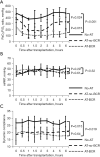Lung recruitment after cardiac arrest during procurement of atelectatic donor lungs is a protective measure in lung transplantation
- PMID: 36071787
- PMCID: PMC9442530
- DOI: 10.21037/jtd-22-226
Lung recruitment after cardiac arrest during procurement of atelectatic donor lungs is a protective measure in lung transplantation
Abstract
Background: Brain-dead donors are susceptible to pulmonary atelectasis (AT). In procurement surgery, lung recruitment under circulatory conditions and cold-flushing for atelectatic donor lungs often provoke graft injury due to the acute blood inflow. We hypothesized that lung recruitment without blood circulation can mitigate graft injury. This study aimed to examine the benefits of lung recruitment subsequent to cardiac arrest using a porcine lung-transplant model.
Methods: Thirteen donor pigs were categorized into the non-atelectatic (No-AT) group (n=3) representing a healthy control group; AT-BCR group (n=5), in which AT was reverted by conventional blood-circulated recruitment (BCR); and AT-no-BCR group (n=5), in which AT was reverted by no-BCR following circulatory arrest. In the atelectatic donor models, the left main bronchus was ligated for 24 hours prior to lung procurement. Left lung transplantation (LTx) was subsequently performed in the thirteen recipient pigs. After 6 hours evaluation, the recipients were euthanized and the lung grafts were excised.
Results: The post-transplant PaO2/FiO2 ratio was significantly higher in the AT-no-BCR group than in the AT-BCR group (P=0.015). Wet/dry ratio, histological findings of graft injury and tissue interleukin-8 expression in the AT-no-BCR group were similar to those of the No-AT group.
Conclusions: Lung recruitment without circulation after circulatory arrest could be more protective for atelectatic donor lung than the conventional procedure.
Keywords: Lung transplantation (LTx); atelectasis; lung recruitment maneuver; protective procurement.
2022 Journal of Thoracic Disease. All rights reserved.
Conflict of interest statement
Conflicts of Interest: All authors have completed the ICMJE uniform disclosure form (available at https://jtd.amegroups.com/article/view/10.21037/jtd-22-226/coif). The authors have no conflicts of interest to declare.
Figures






Comment in
-
Donor lung preservation for transplantation-where do we go from here?J Thorac Dis. 2022 Sep;14(9):3125-3130. doi: 10.21037/jtd-22-949. J Thorac Dis. 2022. PMID: 36245629 Free PMC article. No abstract available.
-
Donor lung inflation: are we doing it right?J Thorac Dis. 2022 Sep;14(9):3131-3132. doi: 10.21037/jtd-2022-12. J Thorac Dis. 2022. PMID: 36245634 Free PMC article. No abstract available.
References
LinkOut - more resources
Full Text Sources
